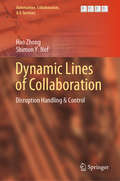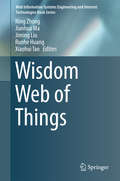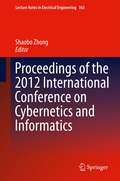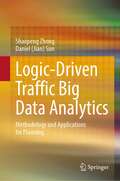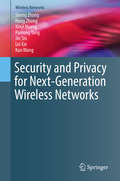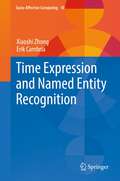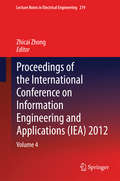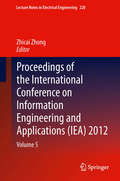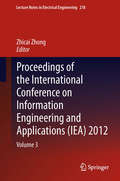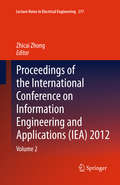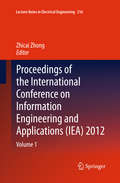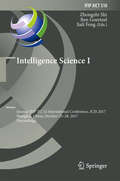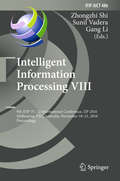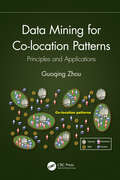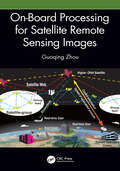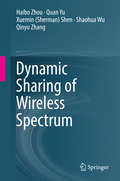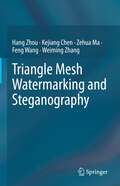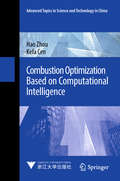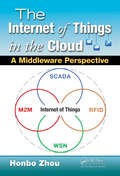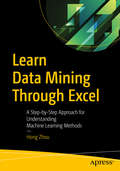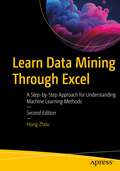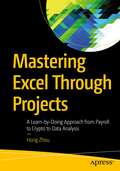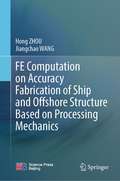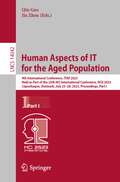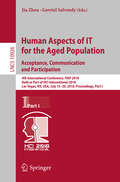- Table View
- List View
Dynamic Lines of Collaboration: Disruption Handling & Control (Automation, Collaboration, & E-Services #6)
by Hao Zhong Shimon Y. NofThis book focuses on the systematic modeling of complex situations characterized by escalating disruptions, and on cycles of dynamic collaboration for the best handling of disruptions. What can we do about disruptive events and their cascading effects? Thanks to the evolution of intelligent technologies for interaction, communication, sharing, and collaboration, cyberspace is a rapidly expanding world. Our systems of machines, software services, and human organizations have become increasingly interdependent, in other words – networked. As a result, disruptions that initially affect only a small part of any network tend to escalate. At the same time, cyber solutions can support first responders and emergency handlers, enhancing their responsiveness and ability to collaborate with one another in controlling disruptions and preventing their escalation. In this book, we are chiefly interested in how effectively these collaborations can be supported and how we can further optimize such support. Solution guidelines for optimizing collaborations are illustrated with examples in various application domains: agricultural robotics, civil cyber-physical infrastructure, visual analytics, manufacturing automation, and supply chains. Open-source simulation tools are also provided to supplement the main content.
Wisdom Web of Things
by Ning Zhong Jianhua Ma Jiming Liu Runhe Huang Xiaohui TaoThis book provides a thorough overview of the Wisdom Web of Things (W2T), a holistic framework for computing and intelligence in an emerging hyper-world with a social-cyber#65533;physical space. Fast-evolving Web intelligence research and development initiatives are now moving toward understanding the multifaceted nature of intelligence and incorporating it at the Web scale in a ubiquitous environment with data, connection and service explosion. The book focuses on the framework and methodology of W2T, as well as its applications in different problem domains, such as intelligent businesses, urban computing, social computing, brain informatics and healthcare. From the researcher and developer perspectives, the book takes a systematic, structured view of various W2T facets and their overall contribution to the development of W2T as a whole. Written by leading international researchers, this book is an essential reference for researchers, educators, professionals, and tertiary HDR students working on the World Wide Web, ubiquitous computing, knowledge management, and business intelligence.
Proceedings of the 2012 International Conference on Cybernetics and Informatics
by Shaobo ZhongProceedings of the International Conference on Cybernetics and Informatics (ICCI 2012) covers the hybridization in control, computer, information, communications and applications. ICCI 2012 held on September 21-23, 2012, in Chongqing, China, is organized by Chongqing Normal University, Chongqing University, Nanyang Technological University, Shanghai Jiao Tong University, Hunan Institute of Engineering, Beijing University, and sponsored by National Natural Science Foundation of China (NSFC). This two volume publication includes selected papers from the ICCI 2012. Covering the latest research advances in the area of computer, informatics, cybernetics and applications, which mainly includes the computer, information, control, communications technologies and applications.
Logic-Driven Traffic Big Data Analytics: Methodology and Applications for Planning
by Shaopeng Zhong Daniel (Jian) SunThis book starts from the relationship between urban built environment and travel behavior and focuses on analyzing the origin of traffic phenomena behind the data through multi-source traffic big data, which makes the book unique and different from the previous data-driven traffic big data analysis literature. This book focuses on understanding, estimating, predicting, and optimizing mobility patterns. Readers can find multi-source traffic big data processing methods, related statistical analysis models, and practical case applications from this book. This book bridges the gap between traffic big data, statistical analysis models, and mobility pattern analysis with a systematic investigation of traffic big data’s impact on mobility patterns and urban planning.
Security and Privacy for Next-Generation Wireless Networks (Wireless Networks)
by Sheng Zhong Hong Zhong Xinyi Huang Panlong Yang Jin Shi Lei Xie Kun WangThis timely book provides broad coverage of security and privacy issues in the macro and micro perspective. In macroperspective, the system and algorithm fundamentals of next-generation wireless networks are discussed. In micro-perspective, this book focuses on the key secure and privacy techniques in different emerging networks from the interconnection view of human and cyber-physical world. This book includes 7 chapters from prominent international researchers working in this subject area. This book serves as a useful reference for researchers, graduate students, and practitioners seeking solutions to wireless security and privacy related issues Recent advances in wireless communication technologies have enabled the large-scale deployment of next-generation wireless networks, and many other wireless applications are emerging. The next generation of mobile networks continues to transform the way people communicate and access information. As a matter of fact, next-generation emerging networks are exploiting their numerous applications in both military and civil fields. For most applications, it is important to guarantee high security of the deployed network in order to defend against attacks from adversaries, as well as the privacy intrusion. The key target in the development of next-generation wireless networks is to promote the integration of the human, cyber, and physical worlds. Previous work in Cyber Physical Systems (CPS) considered the connection between the cyber world and the physical world. In the recent studies, human involvement brings new channels and initiatives in this interconnection. In this integration process, security and privacy are critical issues to many wireless network applications, and it is a paramount concern for the growth of next-generation wireless networks. This is due to the open nature of wireless communication and the involvement of humans. New opportunities for tackling these security and privacy issues in next-generation wireless networks will be achieved by leveraging the properties of interaction among human, computers and things.
Time Expression and Named Entity Recognition (Socio-Affective Computing #10)
by Xiaoshi Zhong Erik CambriaThis book presents a synthetic analysis about the characteristics of time expressions and named entities, and some proposed methods for leveraging these characteristics to recognize time expressions and named entities from unstructured text. For modeling these two kinds of entities, the authors propose a rule-based method that introduces an abstracted layer between the specific words and the rules, and two learning-based methods that define a new type of tagging scheme based on the constituents of the entities, different from conventional position-based tagging schemes that cause the problem of inconsistent tag assignment. The authors also find that the length-frequency of entities follows a family of power-law distributions. This finding opens a door, complementary to the rank-frequency of words, to understand our communicative system in terms of language use.
Proceedings of the International Conference on Information Engineering and Applications (IEA) 2012: 219
by Zhicai ZhongInformation engineering and applications is the field of study concerned with constructing information computing, intelligent systems, mathematical models, numerical solution techniques, and using computers and other electronic devices to analyze and solve natural scientific, social scientific and engineering problems. <P><P> Information engineering is an important underpinning for techniques used in information and computational science and there are many unresolved problems worth studying. The Proceedings of the 2nd International Conference on Information Engineering and Applications (IEA 2012), which was held in Chongqing, China, from October 26-28, 2012, discusses the most innovative research and developments including technical challenges and social, legal, political, and economic issues.<P> A forum for engineers and scientists in academia, industry, and government, the Proceedings of the 2nd International Conference on Information Engineering and Applications presents ideas, results, works in progress, and experience in all aspects of information engineering and applications.
Proceedings of the International Conference on Information Engineering and Applications (IEA) 2012: 220
by Zhicai ZhongInformation engineering and applications is the field of study concerned with constructing information computing, intelligent systems, mathematical models, numerical solution techniques, and using computers and other electronic devices to analyze and solve natural scientific, social scientific and engineering problems. <P><P> Information engineering is an important underpinning for techniques used in information and computational science and there are many unresolved problems worth studying. The Proceedings of the 2nd International Conference on Information Engineering and Applications (IEA 2012), which was held in Chongqing, China, from October 26-28, 2012, discusses the most innovative research and developments including technical challenges and social, legal, political, and economic issues.<P> A forum for engineers and scientists in academia, industry, and government, the Proceedings of the 2nd International Conference on Information Engineering and Applications presents ideas, results, works in progress, and experience in all aspects of information engineering and applications.
Proceedings of the International Conference on Information Engineering and Applications (IEA) 2012: 218
by Zhicai ZhongInformation engineering and applications is the field of study concerned with constructing information computing, intelligent systems, mathematical models, numerical solution techniques, and using computers and other electronic devices to analyze and solve natural scientific, social scientific and engineering problems. <P><P> Information engineering is an important underpinning for techniques used in information and computational science and there are many unresolved problems worth studying. The Proceedings of the 2nd International Conference on Information Engineering and Applications (IEA 2012), which was held in Chongqing, China, from October 26-28, 2012, discusses the most innovative research and developments including technical challenges and social, legal, political, and economic issues.<P> A forum for engineers and scientists in academia, industry, and government, the Proceedings of the 2nd International Conference on Information Engineering and Applications presents ideas, results, works in progress, and experience in all aspects of information engineering and applications.
Proceedings of the International Conference on Information Engineering and Applications (IEA) 2012: 217
by Zhicai ZhongInformation engineering and applications is the field of study concerned with constructing information computing, intelligent systems, mathematical models, numerical solution techniques, and using computers and other electronic devices to analyze and solve natural scientific, social scientific and engineering problems. <P><P> Information engineering is an important underpinning for techniques used in information and computational science and there are many unresolved problems worth studying. The Proceedings of the 2nd International Conference on Information Engineering and Applications (IEA 2012), which was held in Chongqing, China, from October 26-28, 2012, discusses the most innovative research and developments including technical challenges and social, legal, political, and economic issues.<P> A forum for engineers and scientists in academia, industry, and government, the Proceedings of the 2nd International Conference on Information Engineering and Applications presents ideas, results, works in progress, and experience in all aspects of information engineering and applications.
Proceedings of the International Conference on Information Engineering and Applications (IEA) 2012: Volume 1
by Zhicai ZhongInformation engineering and applications is the field of study concerned with constructing information computing, intelligent systems, mathematical models, numerical solution techniques, and using computers and other electronic devices to analyze and solve natural scientific, social scientific and engineering problems. <P><P> Information engineering is an important underpinning for techniques used in information and computational science and there are many unresolved problems worth studying. The Proceedings of the 2nd International Conference on Information Engineering and Applications (IEA 2012), which was held in Chongqing, China, from October 26-28, 2012, discusses the most innovative research and developments including technical challenges and social, legal, political, and economic issues.<P> A forum for engineers and scientists in academia, industry, and government, the Proceedings of the 2nd International Conference on Information Engineering and Applications presents ideas, results, works in progress, and experience in all aspects of information engineering and applications.
Intelligence Science I: Second IFIP TC 12 International Conference, ICIS 2017, Shanghai, China, October 25-28, 2017, Proceedings (IFIP Advances in Information and Communication Technology #510)
by Zhongzhi Shi, Ben Goertzel and Jiali FengThis book constitutes the refereed proceedings of the Second International Conference on Intelligence Science, ICIS 2017, held in Shanghai, China, in October 2017.The 38 full papers and 9 short papers presented were carefully reviewed and selected from 82 submissions. They deal with key issues in intelligence science and have been organized in the following topical sections: theory of intelligence science; cognitive computing; big data analysis and machine learning; machine perception; intelligent information processing; and intelligent applications.
Intelligent Information Processing VIII: 9th IFIP TC 12 International Conference, IIP 2016, Melbourne, VIC, Australia, November 18-21, 2016, Proceedings (IFIP Advances in Information and Communication Technology #486)
by Zhongzhi Shi, Sunil Vadera and Gang LiThis book constitutes the refereed proceedings of the 9th IFIP TC 12 International Conference on Intelligent Information Processing, IIP 2016, held in Melbourne, VIC, Australia, in October 2016. The 24 full papers and 3 short papers presented were carefully reviewed and selected from more than 40 submissions. They are organized in topical sections on machine learning, data mining, deep learning, social computing, semantic web and text processing, image understanding, and brain-machine collaboration.
Data Mining for Co-location Patterns: Principles and Applications
by Guoqing ZhouCo-location pattern mining detects sets of features frequently located in close proximity to each other. This book focuses on data mining for co-location pattern, a valid method for identifying patterns from all types of data and applying them in business intelligence and analytics. It explains the fundamentals of co-location pattern mining, co-location decision tree, and maximal instance co-location pattern mining along with an in-depth overview of data mining, machine learning, and statistics. This arrangement of chapters helps readers understand the methods of co-location pattern mining step-by-step and their applications in pavement management, image classification, geospatial buffer analysis, etc.
On-Board Processing for Satellite Remote Sensing Images
by Guoqing ZhouOn-board image processing systems are used to maximize image data transmission efficiency for large volumes of data gathered by Earth observation satellites. This book explains the methods, mathematical models, and key technologies used for these systems. It introduces the background, basic concepts, and the architecture of on-board image processing, along with on-board detection of the image feature and matching, ground control point identification, on-board geometric correction, calibration, geographic registration, etc. • Describes algorithms and methodologies for on-board image processing with FPGA chips. • Migrates the traditional on-ground computing to on-board operation and the image processing is implemented on-board, not on-ground. • Introduces for the first time many key technologies and methods for on-board image processing. • Emphasizes the recent progress in image processing by using on-board FPGA chips. • Includes case studies from the author’s extensive research and experience on the topic. This book gives insights into emerging technologies for on-board processing and will benefit senior undergraduate and graduate students of remote sensing, information technology, computer science and engineering, electronic engineering, and geography, as well as researchers and professionals interested in satellite remote sensing image processing in academia, and governmental and commercial sectors.
Dynamic Sharing of Wireless Spectrum
by Haibo Zhou Quan Yu Xuemin Sherman Shen Shaohua Wu Qinyu ZhangThis book focuses on the current research on the dynamic spectrum sharing for efficient spectrum resource utilization, which covers the overlay spectrum sharing, underlay spectrum sharing and database-assisted spectrum sharing related research issues. Followed by a comprehensive review and in-depth discussion of the current state-of-the-art research literature and industry standardization, this book first presents a novel overlay spectrum sharing framework for dynamic utilization of available cellular frequency bands, formulates the dynamic spectrum sharing problem as a dynamic resource demand-supply matching problem, and accordingly develops a distributed fast spectrum sharing algorithm to solve the resource matching problem. A self-awareness power control approach for multi-hop routing selection is proposed, which can establish an effective and practical routing selection optimization in secondary access networks and minimize the interference to primary users. Finally, this book offers dynamic secondary access scheme for database-assisted spectrum sharing networks, which is targeted to support the prosperous wireless multimedia networking applications by leveraging the TV white spaces of geolocation databases while satisfying QoS guarantees of secondary users. The overlay spectrum sharing, underlay spectrum sharing, and database-assisted white spaces spectrum sharing research results that are presented in this book provide useful insights for the design of next generation wireless access networks. This book motivates a new line of thinking for efficient spectrum resource utilization and performance enhancements of future wireless access applications.
Triangle Mesh Watermarking and Steganography
by Hang Zhou Kejiang Chen Zehua Ma Feng Wang Weiming ZhangThis book provides a systematic overview of watermarking and steganography methods for triangle meshes related to computer graphics and security. The significance of this research has been well recognized by the growing body of work on watermarking, steganography and steganalysis of 3D meshes. With the evolution of the CAD industry and real-world end-user applications such as virtual reality (VR) and 3D printing, 3D meshes have attracted world-wide attention. Besides, the flexible data structure of 3D geometry provides enough space to embed secret information, making it ideal for applications such as copyright protection and covert communication. Our goal of the book is to allow readers to systematically understand 3D mesh information hiding technology and its applications as a whole. The book outlines comprehensive techniques, including handcrafted and deep learning-based techniques, digital and physical techniques in the literature and provides standard evaluation metrics for triangle meshes. The up-to-date geometrical deep learning and 3D printing-related algorithms are also covered. Offering a rich blend of ideas and algorithms, the book is up-to-date and self-contained. It is an excellent reference resource for users who are seeking 3D mesh watermarking and steganography algorithms, as well as for graduate students and researchers wanting to grasp the frontiers of triangular mesh processing on data hiding.
Combustion Optimization Based on Computational Intelligence (Advanced Topics in Science and Technology in China)
by Hao Zhou Kefa CenThis book presents the latest findings on the subject of combustion optimization based on computational intelligence. It covers a broad range of topics, including the modeling of coal combustion characteristics based on artificial neural networks and support vector machines. It also describes the optimization of combustion parameters using genetic algorithms or ant colony algorithms, an online coal optimization system, etc. Accordingly, the book offers a unique guide for researchers in the areas of combustion optimization, NOx emission control, energy and power engineering, and chemical engineering.
The Internet of Things in the Cloud: A Middleware Perspective
by Honbo ZhouAlthough the Internet of Things (IoT) is a vast and dynamic territory that is evolving rapidly, there has been a need for a book that offers a holistic view of the technologies and applications of the entire IoT spectrum. Filling this void, The Internet of Things in the Cloud: A Middleware Perspective provides a comprehensive introduction to the Io
Learn Data Mining Through Excel: A Step-by-Step Approach for Understanding Machine Learning Methods
by Hong ZhouUse popular data mining techniques in Microsoft Excel to better understand machine learning methods.Software tools and programming language packages take data input and deliver data mining results directly, presenting no insight on working mechanics and creating a chasm between input and output. This is where Excel can help.Excel allows you to work with data in a transparent manner. When you open an Excel file, data is visible immediately and you can work with it directly. Intermediate results can be examined while you are conducting your mining task, offering a deeper understanding of how data is manipulated and results are obtained. These are critical aspects of the model construction process that are hidden in software tools and programming language packages.This book teaches you data mining through Excel. You will learn how Excel has an advantage in data mining when the data sets are not too large. It can give you a visual representation of data mining, building confidence in your results. You will go through every step manually, which offers not only an active learning experience, but teaches you how the mining process works and how to find the internal hidden patterns inside the data.What You Will LearnComprehend data mining using a visual step-by-step approachBuild on a theoretical introduction of a data mining method, followed by an Excel implementationUnveil the mystery behind machine learning algorithms, making a complex topic accessible to everyoneBecome skilled in creative uses of Excel formulas and functionsObtain hands-on experience with data mining and ExcelWho This Book Is ForAnyone who is interested in learning data mining or machine learning, especially data science visual learners and people skilled in Excel, who would like to explore data science topics and/or expand their Excel skills. A basic or beginner level understanding of Excel is recommended.
Learn Data Mining Through Excel: A Step-by-Step Approach for Understanding Machine Learning Methods
by Hong ZhouUse popular data mining techniques in Microsoft Excel to better understand machine learning methods. Most software tools and programming language packages take data input and deliver data mining results directly, presenting no insight on working mechanics and creating a chasm between input and output. This is where Excel can help, and this book will show you exactly how. This updated edition demonstrates how to work with data in a transparent manner using Excel. When you open an Excel file, data is visible immediately and you can work with it directly. You’ll see how to examine intermediate results even as you are still conducting your mining task, offering a deeper understanding of how data is manipulated, and results are obtained. These are critical aspects of the model construction process that are often hidden in software tools and programming language packages. Over the course of Learn Data Mining Through Excel, you will learn the data mining advantages the application offers when the data sets are not too large. You’ll see how to use Excel’s built-in features to create visual representations of your data, enabling you to present your findings in an accessible format. Author Hong Zhou walks you through each step, offering not only an active learning experience, but teaching you how the mining process works and how to find hidden patterns within the data. Upon completing this book, you will have a thorough understanding of how to use an application you very likely already have to mine and analyze data, and how to present results in various formats. What You Will Learn Comprehend data mining using a visual step-by-step approachGain an introduction to the fundamentals of data miningImplement data mining methods in ExcelUnderstand machine learning algorithmsLeverage Excel formulas and functions creativelyObtain hands-on experience with data mining and Excel Who This Book Is For Anyone who is interested in learning data mining or machine learning, especially data science visual learners and people skilled in Excel who would like to explore data science topics and/or expand their Excel skills. A basic or beginner level understanding of Excel is recommended.
Mastering Excel Through Projects: A Learn-by-Doing Approach from Payroll to Crypto to Data Analysis
by Hong ZhouMaster Excel in less than two weeks with this unique project-based book! Let’s face it, we all master skills in our own way, but building a soup-to-nuts project is one of the best ways to make learning stick and get up to speed quickly. Whether you are just getting started with Excel or are an experienced user, this book will elevate your knowledge and skills. For a beginner, the micro examples in each chapter will warm you up before you dive into the projects. For experienced users, the projects, especially those with table setup considerations, will help you become more creative in your interactions with Excel. Readers will benefit from building eight unique projects, each covering a different topic, including a word game, a food nutrition ranking, a payroll (tax withholding) calculation, an encryption, a two-way table, a Kaplan-Meier analysis, a data analysis via a pivot table and the K-means Clustering data mining method. Through these projects, you will experience firsthand how Excel skills are organized together to accomplish tasks that sound complex and daunting when first described. Get started with a word game which asks users to find English words that amount to exactly 100 points, with each letter of the alphabet assigned a point 1, 2, 3, … 26, respectively. You will disassemble a word into letters and then sum up their points, and then take it one step further, contemplating how to make the completed Excel worksheet more user friendly and completely automated. Increasingly challenging tasks like this example build on what you have learned and increase your confidence along the way, ensuring your mastery of Excel. What You Will Learn Gain confidence to tackle a challenging Excel-related mission, even those that seem impossibleBecome skilled in the creative uses of Excel formulas and functions and other built-in features Appreciate the art of refining worksheets to maximize automationUnderstand the value of treating each worksheet as a unique product Who This Book Is ForPeople who are interested in learning Excel as quickly and efficiently as possible. While Excel beginners and intermediate users are the primary audience, experienced Excel users might also discover new skills and ways of working with Excel.
FE Computation on Accuracy Fabrication of Ship and Offshore Structure Based on Processing Mechanics
by Hong ZHOU Jiangchao WANGThis book provides insight on processing mechanics during ship and offshore structure, and researchers, scientists, and engineers in the field of manufacturing process mechanics can benefit from the book. This book is written by subject experts based on the recent research results in FE computation on accuracy fabrication of ship and offshore structures based on processing mechanics. In order to deal with actual engineering problems during construction of ship and offshore structure, it proposes advanced computational approaches such as thermal elastic–plastic and elastic FE computations and employed to examine physical behavior and clarifies generation mechanism of mechanical response. As such, this book provides valuable knowledge, useful methods, and practical algorithms that can be considered in manufacturing process mechanics.
Human Aspects of IT for the Aged Population: 9th International Conference, ITAP 2023, Held as Part of the 25th HCI International Conference, HCII 2023, Copenhagen, Denmark, July 23–28, 2023, Proceedings, Part I (Lecture Notes in Computer Science #14042)
by Jia Zhou Qin GaoThis two-volume set of ITAP 2023, constitutes the refereed proceedings of the 9th International Conference on Human Aspects of IT for the Aged Population, ITAP 2023, held as Part of the 24th International Conference, HCI International 2023, which took place in July 2023 in Copenhagen, Denmark.The total of 1578 papers and 396 posters included in the HCII 2023 proceedings volumes was carefully reviewed and selected from 7472 submissions. The papers of ITAP 2023 Part I are organized in topical sections named: Designing and Assessing the Older Users' Experience; Aging and Social Media; Voice Assistants and Chatbots; Games and Exergames for Older People.
Human Aspects of IT for the Aged Population. Acceptance, Communication and Participation: 4th International Conference, ITAP 2018, Held as Part of HCI International 2018, Las Vegas, NV, USA, July 15–20, 2018, Proceedings, Part I (Lecture Notes in Computer Science #10926)
by Jia Zhou Gavriel SalvendyThis book constitutes the proceedings of the 4th International Conference onHuman Aspects of IT for the Aged Population, ITAP 2018, held as part of the 20th International Conference, HCI International 2018, which took place in Las Vegas, Nevada, in July 2018.The total of 1171 papers and 160 posters included in the 30 HCII 2018 proceedings volumes was carefully reviewed and selected from 4346 submissions. ITAP 2018 includes a total of 84 papers. They were organized in topical sections as follows: Part I: aging and technology acceptance; aging and interaction; intergenerational communication and social participation. Part II: health care technologies and services for the elderly; intelligent environments for aging; and games and entertainment for the elderly.
